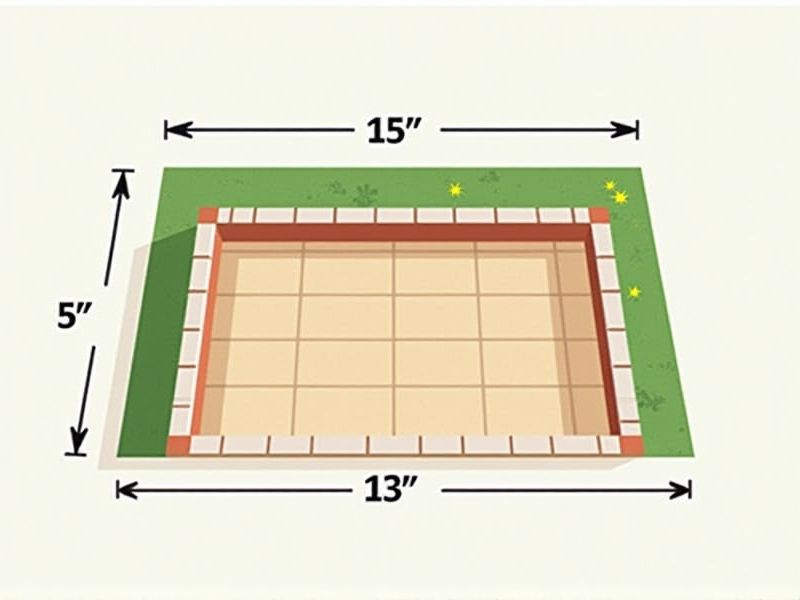
When planning a patio, it's helpful to know that typical patio dimensions range from about 12 feet by 12 feet for a small seating area to 16 feet by 18 feet or larger for a space that includes a dining table and additional chairs. For comfortable movement, allow at least 3 feet of clearance around furniture and pathways. Consider the size of your outdoor furniture and how you'll use the space--for example, hosting guests or simply relaxing. Customizing your patio dimensions to fit your specific needs will ensure it's both functional and inviting.
Commonly 12X12 Feet For Small Patios
The standard size for small patios generally measures 12x12 feet, providing a compact yet functional outdoor space. This dimension allows for versatile furniture arrangements, accommodating a small dining set or a couple of lounge chairs comfortably. Many homeowners find that such a size enables them to incorporate landscaping features, like planters or decorative stones, enhancing the aesthetic appeal. Opting for a 12x12 patio can also improve your property's value by creating an inviting outdoor area.
Average Size Around 16X18 Feet
A standard patio typically measures around 16 by 18 feet, offering ample space for outdoor furniture and activities. This size accommodates a dining table, chairs, and perhaps even a grill, making it ideal for gatherings. You can also enhance your outdoor experience with features such as potted plants and decorative lighting. The average square footage of this patio size is approximately 288 square feet, providing a substantial area for relaxation and entertainment.
Large Patios Often 20X25 Feet
Large patios, averaging dimensions of 20x25 feet, provide ample outdoor space for various activities, from gatherings to relaxation. This size allows for the incorporation of furniture, such as outdoor seating and dining sets, while maintaining a comfortable flow of movement. When designing, consider materials like pavers or concrete, which enhance durability and style. Your patio can become a versatile extension of your home, perfect for enjoying outdoor living year-round.
Consider Furniture Layout Space
Maximizing your patio space can enhance both aesthetics and functionality, with an ideal furniture layout that accommodates at least 3 to 4 seating areas for gatherings. A rectangular or square table is recommended, measuring 60-72 inches long, allowing ample space for dinnerware and utensils. Incorporating multifunctional furniture, such as storage benches or folding chairs, can optimize your area while offering flexibility. Ensure a clearance of 3 feet around seating arrangements to maintain comfort and accessibility for you and your guests.
Pathway Navigation Space
The standard for patio design emphasizes the importance of pathway navigation space, which should ideally be at least 36 inches wide to ensure comfortable movement. Incorporating materials like porous pavers can improve drainage, reducing water pooling and enhancing safety. Clear signage and designated walkways can guide visitors, improving overall accessibility and navigation through the outdoor space. Effective lighting solutions, such as solar-powered path lights, can illuminate pathways, making them safer and more inviting during evening use.
Allow Space For Planters Or Decor
A well-designed patio should allocate at least 10-15% of its total area for planters or decorative elements, enhancing both aesthetics and usability. Incorporating planters filled with seasonal flowers can create vibrant focal points while supporting local biodiversity. Your choice of decor, such as outdoor art or lighting, should complement the natural surroundings and not overcrowd the space. Ensuring adequate space for these features encourages an inviting atmosphere suitable for relaxation or entertainment.
Proportion To House Size
A patio should ideally maintain a proportionate size in relation to your house, with an optimal ratio being around 20% to 30% of the total outdoor area. For example, if your backyard spans 1,000 square feet, a patio ranging from 200 to 300 square feet complements your home perfectly. This balance enhances the aesthetic appeal while ensuring functionality, allowing sufficient space for outdoor furniture and activities. Careful consideration of proportion not only maximizes usability but also increases your property's value, making it more attractive to potential buyers.
Barbecue Or Cooking Area Space
Designing a patio with a barbecue or cooking area typically requires a minimum space of 100 square feet for a comfortable layout. A dedicated zone with quality materials, such as stainless steel grills and heat-resistant surfaces, ensures durability and functionality. Consider incorporating features like a stone countertop or built-in seating to enhance the outdoor cooking experience. Investing in proper ventilation and safety elements is essential to maintain a safe and enjoyable atmosphere, allowing you to entertain guests effortlessly.
Dining Vs Relaxation Zones
Designing a patio involves crafting distinct zones, with a focus on dining and relaxation. A well-defined dining area typically includes a table with seating for six to eight people, ideally under a shade structure, rated for UV protection. In contrast, the relaxation zone features comfortable seating, like lounge chairs or a sectional, often accompanied by a fire pit or water feature to enhance ambiance. When allocating space, aim for at least 20 to 30 square feet for each zone to ensure functionality and comfort.
Local Building Regulations Compliance
Patio construction must adhere to local building regulations, which often specify minimum standards for dimensions, materials, and structural integrity. Common requirements include a minimum thickness of 4 inches for concrete slabs and a specific maximum slope of 2% to ensure proper drainage. In urban areas, setbacks from property lines may also be required, typically ranging from 3 to 5 feet, depending on local zoning laws. Ensuring compliance not only enhances safety but also protects your investment by avoiding potential fines and enabling smooth approval processes.
